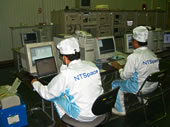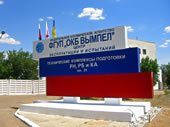Topics List
Sep. 24, 2009 Updated
KIRARI: Signals stopped; successful operation ends
|
At 2:48 p.m. on Sept. 24, 2009, signal transmissions to the Optical Inter-orbit Communications Engineering Test Satellite "KIRARI" (OICETS) were terminated, and its operation was completed. The KIRARI was initially scheduled to be operated in orbit for about one year, but it survived for four years, much longer than the original plan. The KIRARI was launched by the Dnepr Launch Vehicle from the Baikonur Cosmodrome, Kazakhstan, on Aug. 24, 2005, and made many achievements in the space optical communication area including bi-directional optical inter-satellite communication and links between a lower-orbit satellite and a ground optical station. |
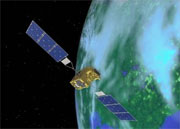
|
|---|
Sep. 9, 2009 Updated
KIRARI completes post-mission utilization phase; signal transmission will be stopped on Sep. 24.
|
The Optical Inter-orbit Communications Engineering Test Satellite "KIRARI" has been in the latter part of the post-mission utilization phase since Oct. 2006. JAXA has conducted various optical communication tests in cooperation with the National Institute of Information and Communication Technology (NICT) and other overseas space organizations. On September 9, JAXA reported to the Space Activities Commission on the achievements and initiative for studying the next generation optical communication technology. We will stop sending signals to the satellite on September 24 (spare days 25 thru 30.) |
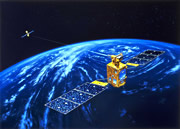 |
|---|
Nov. 2, 2006 Updated
Mission operation completed with "extra success"
|
On Oct. 16 (Japan Standard Time, JST), the mission operation of the "Kirari (OICETS)" was completed after successful experiments with a GEO satellite and optical ground stations. |
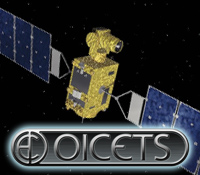 |
|---|
Dec. 13, 2005 Updated
First success of the optical inter-orbit communication over 40,000 km
|
On December 9 (Japan Standard Time, JST), JAXA succeeded in an optical communication experiment between the "Kirari", which was launched by Ukraine's Dnepr launch vehicle on Aug. 24 (JST), and the Advanced Relay and Technology Mission (ARTEMIS) of the European Space Agency (ESA). The experiment was for two satellites that are moving several kilometers per second in respective orbits to communicate over a distance of about 40,000 kilometers. This requires a highly advanced controlling technology that can be described as like "hitting the eye of a needle on the top of Mt. Fuji from Tokyo Station." This success was a global first. |
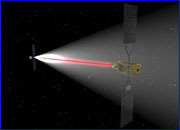 |
|---|
Nov. 21, 2005 Updated
Communication test successful using radio frequency with the ARTEMIS of the ESA
|
|
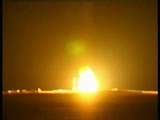 |
|---|
Sep. 28, 2005 Updated
Kirari (OICETS): one month has passed since its launch
|
|
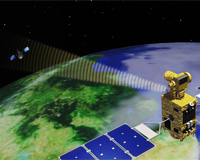 |
|---|
Aug. 24, 2005 Updated
OICETS and INDEX launched
|
The Optical Inter-orbit Communications Engineering Test Satellite (OICETS) and the Innovative Technology Demonstration Experiment Satellite (INDEX) were launched at 6:10 a.m. on August 24, 2005, (Japan Standard Time, JST) by a Dnepr Launch Vehicle* from the Baikonur Cosmodrome in the Republic of Kazakhstan. |
 |
|---|
Aug. 18, 2005 Updated
Countdown for launch
|
The satellites are under preparation for an early morning launch on Aug. 24 (JST). |
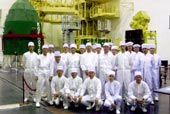 Photo 1 |
|---|
Jul. 21, 2005 Updated
Launch site operations are in progress at Baikonur Cosmodrome
|
After completing the satellite health check with an electric performance test, the OICETS has been under battery reconditioning operations for 50 hours.
Photo 1 |
|
|---|
May 26, 2005 Updated
OICETS Press Release
|
The Optical Inter-orbit Communication Engineering Test Satellite (OICETS) was shown to the press at the Tsukuba Space Center on May 26. The OICETS will be launched by a Dnepr Launch Vehicle this summer. |
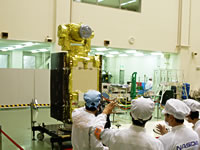 |
|---|
Apr. 26, 2005 Updated
End-to-end test held with DRTS
|
An end-to-end test was held for the OICETS between Apr. 18 and 22 to test communications by establishing a line between two ends to simulate actual operations. At one end was the OICETS, which was in the Spacecraft Integration and Test Building (SITE) at the Tsukuba Space Center (TKSC), and at the other end was the Data Relay Test Satellite (Kodama) in a Geostationary orbit. |
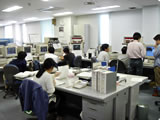 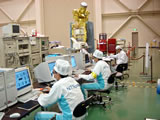 |
|---|
Apr. 11, 2005 Updated
OICETS undergoing flight configuration
|
The OICETS, which is scheduled to be launched this coming summer, has been receiving a project checkup and modifications for coping with the change of inclination (from 35 to 98 degrees) due to a change of the launch vehicle. After all modifications were completed, the final satellite verification started in February, and all operations at the manufacturer's plant have been completed. |
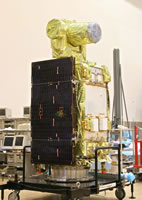 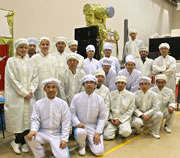 |
|---|
Feb. 7, 2005 Updated
Critical Design Review (CDR) completed in icy Ukraine
|
The Critical Design Review (CDR) was held between Jan. 17 and 28 at SDO Yuzhnoye, (in Dnepropetrovsk, the Ukraine), which is the manufacturer of the Dnepr Launch Vehicle. The purpose of the CDR was to verify if the launch vehicle design and specifications met the satellite requirements for determining their interface conditions. |
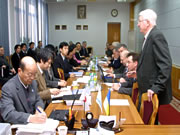 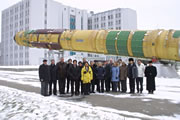 |
|---|
Dec. 27, 2004 Updated
Meeting held with ESA for OICETS
|
The ARTEMIS-OICETS Meeting was held between Sep. 29 and Oct. 1 at the Tsukuba Space Center. The two parties reviewed the result of the optical communications test between the ground and the satellite held in Tenerife, Canary Island, Spain, in Sep. 2003, then discussed the status of the ARTEMIS (launched on July 12, 2001), the OICETS, and future cooperative relations. |
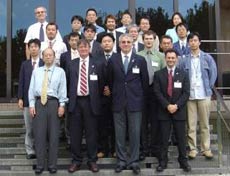 |
|---|
Sep. 25, 2003 Updated
|
Optical communications test using laser beams was carried out between an engineering model of the Laser Utilization Communications Equipment (LUCE) of the OICETS and a geostationary satellite "ARTEMIS". The engineering model of the LUCE was brought into the ESA optical ground station in Tenerife, Canary Island, Spain, off the coast of Morocco, to perform the test. The location of the station is favorable to carry out an optical communications test with a satellite in orbit because it is at the height of 2,400 meters in Mount Teide, where the influence of the atmosphere is small. |
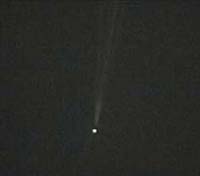 |
|---|
May 2, 2003 Updated
|
The Optical Inter-orbit Communications Engineering Test Satellite (OICETS) has completed a proto-flight test as the final check-up for being ready for launch, but is now in storage due to the mishap of ARTEMIS, a satellite of the European Space Agency (ESA), which was launched into unexpected orbit. |
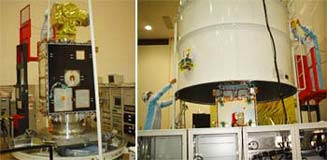 |
|---|
Dec. 27, 2001 Updated
|
To confirm the compatibility between the Optical Inter-orbit Communications Engineering Test Satellite (OICETS) and the ground operation system, NASDA conducted a series of test simulating real operation. |
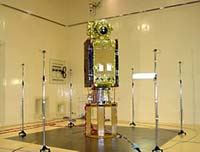 |
|---|
Apr. 7, 2000 Updated
|
The integrated acquisition/tracking test under micro vibration environment was conducted to evaluate the influence of vibration caused by the on board driving equipment such as solar paddle driving mechanisms against acquisition/tracking capabilities of LUCE. In this test, LUCE engineering model was installed on the OICETS structure model and hung to avoid the effect of external disturbance. LUCE acquisition/tracking capabilities were measured, operating driving equipment in different combination. |
 |
|---|
Feb. 25, 2000 Updated
|
When we develop such an equipment like LUCE whose performance are specified by µ radian order, measurement equipment becomes an essential factor. The photograph shows the test of LUCE using optical characteristic test equipment newly developed on the level block, which is floated by the air spring in order to prevent influence of external vibration. In addition, this test room is maintained as clean as semiconductor factories to protect optical equipment. |
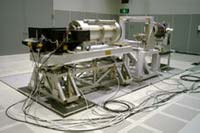 |
|---|
Jan. 14, 2000 Updated
|
Nickel-Metal Hydride (Ni-MH) battery which to be installed in OICETS achieves more compact and lighter (higher energy density) component, while maintaining similar interfaces, compared to Nickel cadmium battery, which is popularly used in current satellites. |
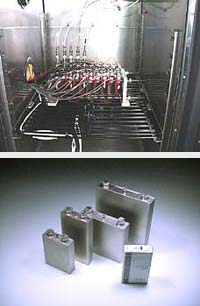 |
|---|
Dec. 3, 1999 Updated
|
We held the Critical Mission Review (CMR) with ARTEMIS project manager of ESA. In this review, it was confirmed that the requirements for the interface between ARTEMIS and OICETS were met based on the test results of LUCE EM and the data acquired from ESA's ARTEMIS. |
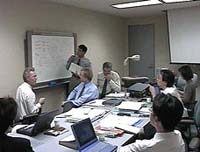 |
|---|
Nov. 5, 1999 Updated
|
This animation shows the concept of the movement of the optical part of Laser Utilizing Communications Equipment (LUCE) during acquisition/tracking phase. |
 |
|---|
Sep. 3, 1999 Updated
|
The optical antenna is a reflecting telescope with highly-accurate polished mirror, whose purpose is to send/receive the laser beam. Its structure is all made of glasses so that distortion which is caused by thermal expansion can be reduced to the minimum. Canon Inc., which is responsible for its manufacture, have carefully conducted the inspection because a small scratch could cause a structural destruction. |
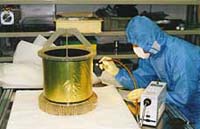 |
|---|
Jul. 26, 1999 Updated
|
The laser beam of Optical Inter-orbit Communication only diverges approximately several millimeters in one kilometer. In order to communicate through this laser beam, the "beam pointing" must be accurately controlled. Its performance was tested in vacuum chamber at simulative space thermal vacuum environment. |
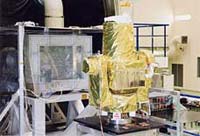 |
|---|

